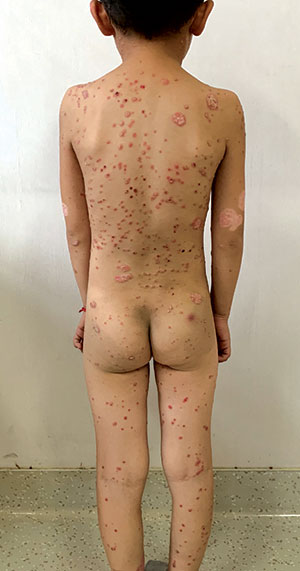A 6-year-old boy presented with rash over whole body for a
week, and past history of upper respiratory tract infection two
weeks ago. Examination revealed extensive guttate erythema with
overlying tiny scales; individual lesions measured about 2-10 mm
in diameter, and predominantly involved the extremities and
trunks (Fig. 1). The rest of the physical examination was normal
except tonsillar enlargement. Anti-streptolysin O(ASO) antibody
was positive. After receiving the narrowband UVB phototherapy
and oral penicillin, the skin lesions gradually faded within 8
weeks, and did not recur over a one-year follow-up.
 |
| Fig. 1 Extensive
guttate erythematous lesions. |
Guttate psoriasis is a subtype of psoriasis characterized
by acute eruption of numerous small, erythematous papules and
plaques. It usually occurs in children and adolescents, but it
can also occur in other age groups. Streptococcus infection is
an important risk factor which can usually precedes its
development by 2-3 weeks; although, the relationship between
streptococcal infection and guttate psoriasis is not fully
understood. Although diagnosis is based on clinical, but in the
difficult cases, skin biopsy is needed. Differential diagnosis
includes pityriasis rosea, tinea corporis, nummular dermatitis
and prurigo nodularis. Guttate psoriasis can spontaneously fade
within several weeks or several months, phototherapy as a
first-line treatment has a good effect, and antibiotics may be
used if persisting infection is suspected. Overall, most
patients have a good prognosis, just a few patients have a
chronic course.

